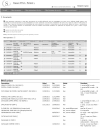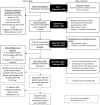A web application to involve patients in the medication reconciliation process: a user-centered usability and usefulness study
- PMID: 30137331
- PMCID: PMC7646908
- DOI: 10.1093/jamia/ocy107
A web application to involve patients in the medication reconciliation process: a user-centered usability and usefulness study
Abstract
Objective: Medication reconciliation (MedRec) can improve patient safety by resolving medication discrepancies. Because information technology (IT) and patient engagement are promising approaches to optimizing MedRec, the SEAMPAT project aims to develop a MedRec IT platform based on two applications: the "patient app" and the "MedRec app." This study evaluates three dimensions of the usability (efficiency, satisfaction, and effectiveness) and usefulness of the patient app.
Methods: We performed a four-month user-centered observational study. Quantitative and qualitative data were collected. Participants completed the system usability scale (SUS) questionnaire and a second questionnaire on usefulness. Effectiveness was assessed by measuring the completeness of the medication list generated by the patient application and its correctness (ie medication discrepancies between the patient list and the best possible medication history). Qualitative data were collected from semi-structured interviews, observations and comments, and questions raised by patients.
Results: Forty-two patients completed the study. Sixty-nine percent of patients considered the patient app to be acceptable (SUS Score ≥ 70) and usefulness was high. The medication list was complete for a quarter of the patients (7/28) and there was a discrepancy for 21.7% of medications (21/97). The qualitative data enabled the identification of several barriers (related to functional and non-functional aspects) to the optimization of usability and usefulness.
Conclusions: Our findings highlight the importance and value of user-centered usability testing of a patient application implemented in "real-world" conditions. To achieve adoption and sustained use by patients, the app should meet patients' needs while also efficiently improving the quality of MedRec.
Figures



References
-
- Claeys C, Foulon V, de Winter S, et al. Initiatives promoting seamless care in medication management: an international review of the grey literature. Int J Clin Pharm 2013; 356: 1040–52. - PubMed
-
- Coleman EA, Smith JD, Raha D, et al. Posthospital medication discrepancies: prevalence and contributing factors. Arch Intern Med 2005; 16516: 1842–7. - PubMed
-
- Bassi J, Lau F, Bardal S.. Use of information technology in medication reconciliation: a scoping review. Ann Pharmacother 2010; 445: 885–97. - PubMed
-
- Kwan JL, Lo L, Sampson M, et al. Medication reconciliation during transitions of care as a patient safety strategy. Ann Intern Med 2013; 158 (5_Part_2): 397–403. - PubMed
-
- Kostas T, Paquin AM, Zimmerman KM, et al. Characterizing medication discrepancies among older adults during transitions of care: a systematic review focusing on discrepancy synonyms, data sources and classification terms. Aging Health 2013; 95: 497–508.
Publication types
MeSH terms
LinkOut - more resources
Full Text Sources
Other Literature Sources

